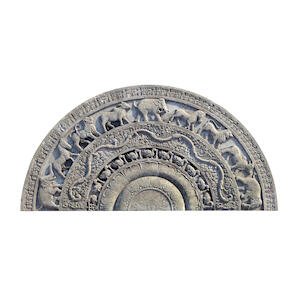Watch Video

 Play Video
Play Video
From a rare Buddhist temple step to ancient Indian and Islamic artefacts, one auction house in London is causing quite a stir with their new lots.
This is the first time a 1000-year-old pre-Hindhu stone step has appeared at an auction. The only other such examples of this kind remain in situ in Sri Lanka.
Weighing at three quarters of a ton, the carved stone features a curved procession of animals, including lions, horses, elephants, birds and cows. Despite being moved around and used in English country gardens for decades, it’s surprisingly still in one piece and in excellent condition.
The lot has attracted interest from around the world with private collectors and museums keen to purchase the historic pieces. Works by three of India's greatest painters are also among the highlights at the Bonhams Indian and Islamic sale. They are predicted to fetch record prices.
"The Tyeb Mehta that we have at 400,000 to 600,000 has never been shown on the market before," said Nour Aslam, Bonhams' specialist of modern and contemporary art from South Asia. "It is very rare of this calibre of the artist. He did very few canvases, and he has always had a great record history with everyone. With Bonhams, this is the first time around that we've had such a spectacular piece of his."
Bonhams says all the estimates are set low in order to attract bidders, but they expect the works to eventually sell for much higher prices.
Source: CCTV.com
10 Jan 2013
Rare Buddhist Anuradhapura period (377 BC - 1017 AD) Indian carved stone temple step discovered by Bonhams in a Devon garden will be sold in London
A carved granite temple step (Sandakada pahana) similar to those found in the ancient city of Anuradhapura in Sri Lanka will be sold in Bonhams Indian and Islamic sale in London on April 23rd.
This magnificent work of art featuring a cow and other animals has come to light in the garden of a Devon bungalow. It is estimated to attract bids in excess of £30,000.
The beautiful 1,000 year old pre-Hindu stone step is one of only six examples known to date from this period, making this discovery the seventh. The temple step is a feature unique to Sinhalese architecture in Sri Lanka.
The massively heavy – three-quarters of a ton stone measure eight ft by four foot and is six inches thick.
Sam Tuke of Bonhams in Exeter says of the discovery: "I met the client when she was collecting an item from our office. She mentioned in passing that she had a large slab of carved granite that had come from her mothers house in Sussex and that she had known and loved it since she was four years old. She loved running her fingers around the animals carved into the stone."
"I said that it sounded an interesting object and she arranged to drop a photograph into me the next day. When I saw the photographs and she explained the full story, I knew that it could be of great historical interest and importance. The house in Sussex had been bought from a tea planter in the 1950's and the stone had been moved six times. Her brother had seen similar stones in Sri Lanka whilst on holiday. She explained that she could not bear to leave the stone behind after her father died and the house was sold. It has been known affectionately in the family as 'The Pebble' and is currently lying outside the front of their bungalow at the end of a concrete path."
The beautifully carved stone features a curved procession of animals including lions, horses, elephants, birds and Brahim cows. Alice Bailey, Head of Department for the Islamic and Indian Art Department, states "It's a truly wonderful find and one of great importance. Identical temple steps can be seen in situ in early 19th century photographs of the monuments of Sri Lanka and the condition and quality of the carving are superb. It is a museum piece."
Anuradhapura and the city of Polonnaruwa are the vitally important attractions in the Sri Lankan cultural triangle. Anuradhapura, the greatest monastic city of the ancient world dates from the middle of the 5th century B.C. and remained the proud seat of kingdom of Sri Lanka until the 11th century A.D. Today Anuradhapura, a UNESCO World Heritage Site, is replete with renovated monuments, restored edifices, preserved ruins and historical sites where the archeological excavations are still being continued.
Anuradhapura was the cradle of the glorious Sinhalese Buddhist civilization. The pride of place in Anuradhapura was taken by the ancient stupas and ancient reservoirs. Towering stupas (dagobas) of stupendous domes, the marvels of ancient civil engineering.
Among the other attractions at Anuradhapura are magnificent rock carvings of richness and grace, colossal stone pillars, Buddhist monasteries and temples and magnificent stone cut swimming pools of sophisticated hydrology.
Source: Bonhams.com

No comments:
Post a Comment